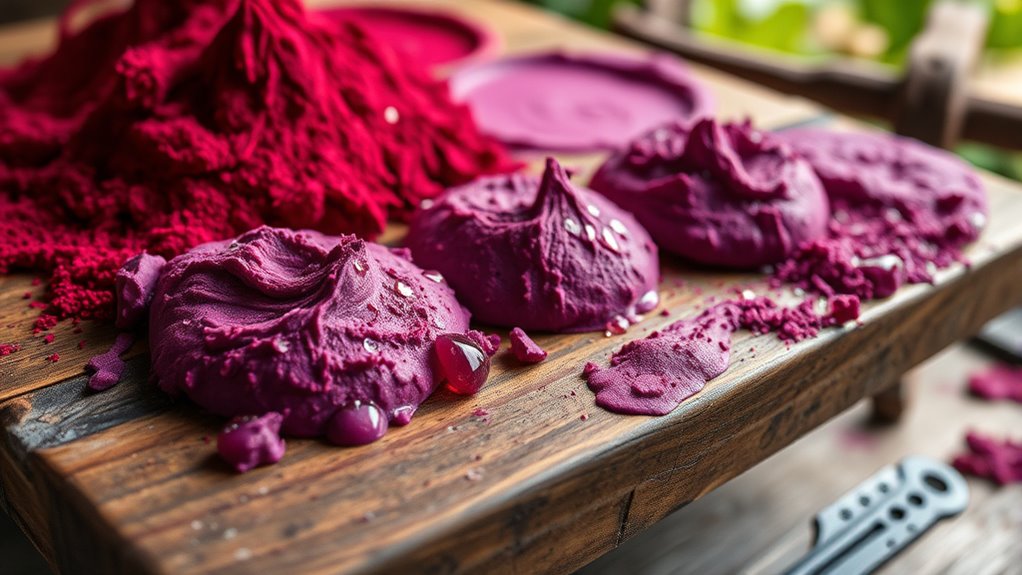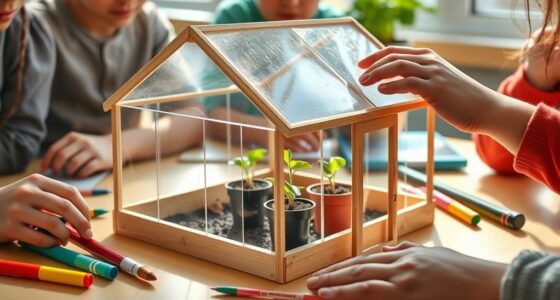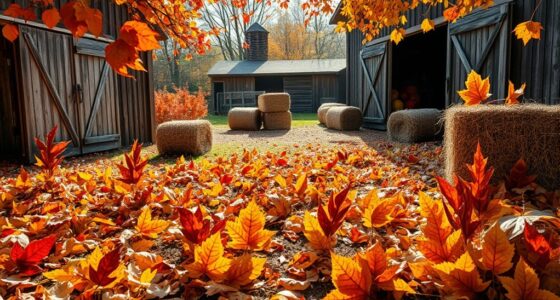Painting with beet juice offers a vibrant, eco-friendly way to create natural farm pigments. You can harvest ripe beets, wash and chop them, then simmer or crush to extract the rich color. Stabilize and enhance the pigment with natural binders and preservatives, and apply your paint with gentle brushes for beautiful effects. Proper storage extends your pigment’s life, allowing you to explore sustainable art techniques. Keep going to discover more inspiring ways to incorporate beet-based colors into your projects.
Key Takeaways
- Beet juice provides vibrant, natural red to purple hues ideal for eco-friendly painting projects.
- Proper harvesting and preparation enhance pigment extraction and color intensity.
- Stabilize and preserve beet-based pigments with natural binders and airtight storage for long-lasting art.
- Use gentle brush techniques and layering methods to achieve desired artistic effects with beet juice paint.
- Incorporate farm-grown ingredients in sustainable art practices, promoting eco-conscious creativity and decor.
Harvesting and Preparing Beets for Pigment Extraction
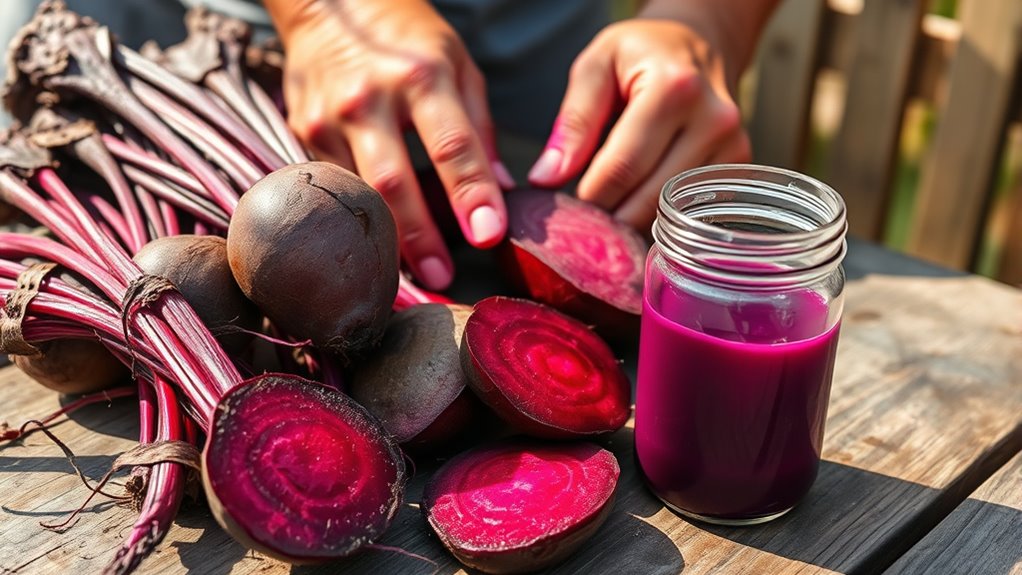
To extract vibrant beet juice for painting, you first need to harvest healthy, mature beets from your garden or local farm. Proper beet farming guarantees you select beets that are fully developed, which directly impacts pigment quality. Look for beets with firm, smooth skins and deep color, avoiding any that show signs of spoilage or damage. Harvest them carefully to prevent bruising, as damaged beets can affect the extraction process and reduce pigment vibrancy. Once harvested, trim the tops and roots, then wash the beets thoroughly to remove dirt and debris. Proper preparation is key to maintaining the quality of the pigment. By selecting the right beets and handling them carefully, you set the foundation for rich, vibrant beet juice perfect for your artwork.
Methods for Extracting and Concentrating Beet Juice
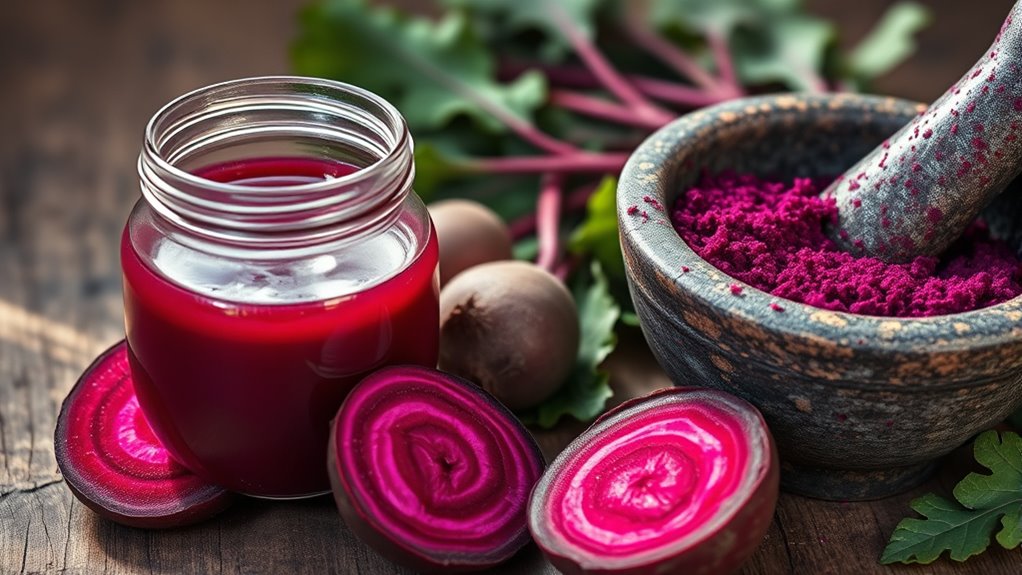
Extracting beet juice begins with chopping the beets into small, even pieces to maximize surface area. Next, you can extract juice by simmering the chopped beets in water, then straining out solids to get a raw juice. To concentrate the pigment, gentle simmering reduces the liquid, intensifying color. Beet juice fermentation is also useful; allowing the juice to ferment slightly can break down cell walls, releasing more pigment and enhancing flavor. During this process, pH adjustment techniques come into play—adding acids or bases helps stabilize the pigment and improve extraction efficiency. Monitoring and adjusting pH levels guarantees the juice maintains a vibrant hue and reduces spoilage risk. Incorporating data privacy concerns into the process ensures that your extraction methods comply with safety standards and protect your ingredients from contamination. These methods yield a concentrated, stable beet juice suitable for use as a natural pigment in your art projects.
Enhancing and Stabilizing Beet Pigments for Art Projects
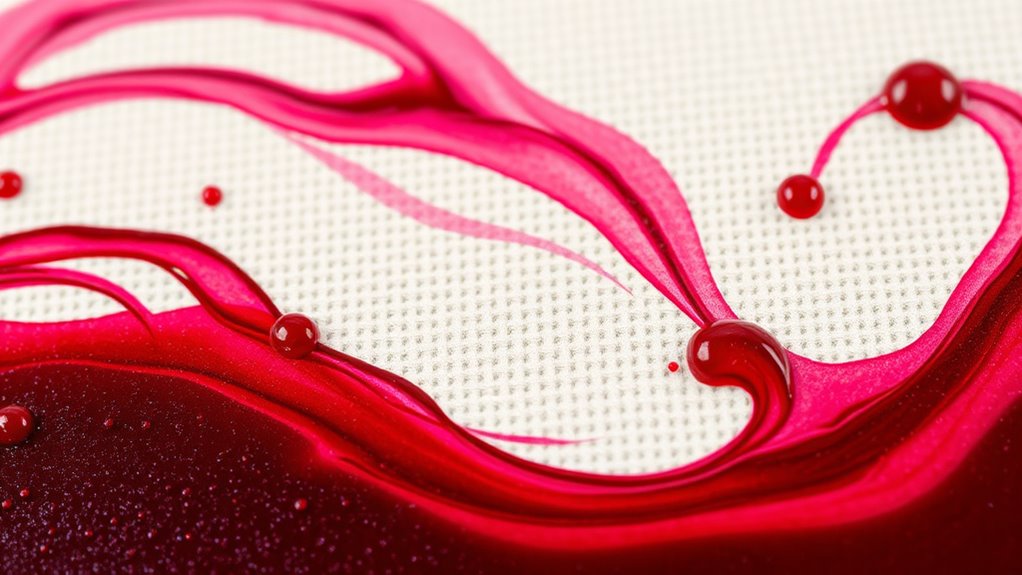
Once you’ve obtained concentrated beet juice, the next step is to enhance and stabilize its pigment for lasting use in your art projects. Botanical blending can help improve pigment stability by mixing beet juice with natural binders like gum arabic or honey, which prevent fading over time. You might also consider adding a small amount of natural fixative, such as beeswax or plant-based resins, to protect the pigment from environmental damage. Stir thoroughly to ensure even distribution and better adhesion. Incorporating natural preservatives can further improve the longevity of your pigments, making them more resistant to degradation. Understanding creative practice can guide you in experimenting with different stabilization techniques to find what best suits your artistic style. Keep in mind that stabilizing beet pigments helps maintain their vibrant color and prevents degradation during storage or application. Using appropriate materials for preservation, such as natural resins, can further extend the longevity of your pigments. Employing proper storage techniques can help preserve your stabilized pigments over time. Implementing proper cookie management practices can help you track how your pigments perform over time and gather feedback for improvements. By carefully enhancing and stabilizing your beet juice, you’ll create a durable, beautiful natural pigment ready for your artistic creations.
Techniques for Applying Beet Juice as Paint
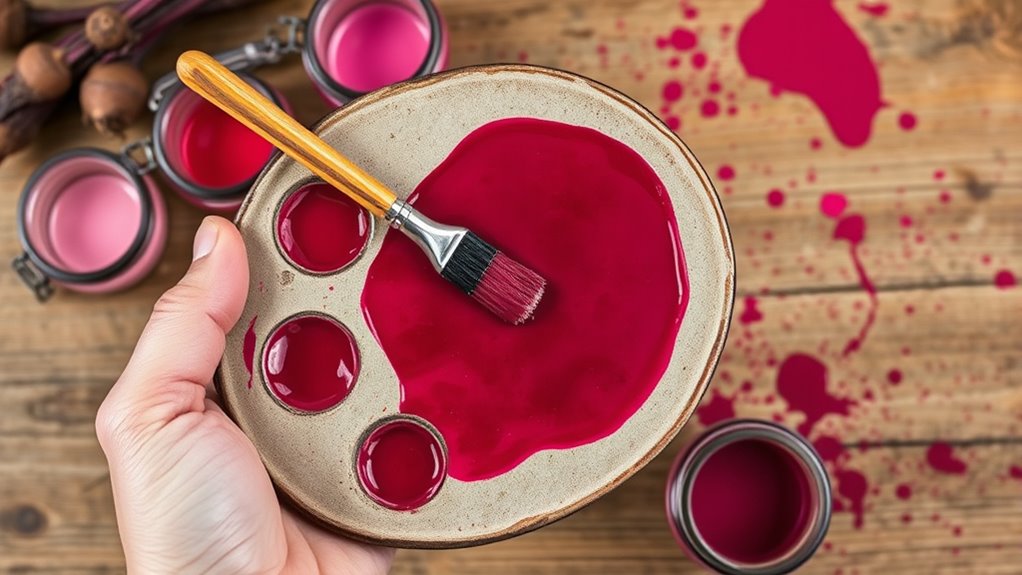
Applying beet juice as paint requires careful technique to achieve smooth, even coverage. Start with gentle brush techniques, using broad, consistent strokes to distribute the pigment evenly across your surface. Light pressure helps prevent streaks or uneven patches. To build depth and vibrancy, employ layering methods—apply thin coats, allowing each to dry before adding the next. This approach enhances color richness without causing cracking or peeling. Experiment with different brush types; flat brushes work well for backgrounds, while fine-tipped brushes are ideal for details. Keep your brush clean and moist to maintain smooth application. Using the right brush type can significantly improve your results. Additionally, incorporating natural pigments like beet juice ensures your artwork remains eco-friendly and vibrant. Understanding sound vibrations can also influence how pigments settle and interact during drying, leading to more harmonious finishes. Patience is key: layering gradually yields a more polished, professional look. With practice, your beet juice paintings will have a beautiful, natural consistency and depth. Incorporating artistic techniques such as blending and shading can further enhance your artwork’s visual appeal. Moreover, paying attention to pigment consistency helps achieve uniform color distribution and better adhesion.
Preserving and Storing Your Natural Beet Pigments
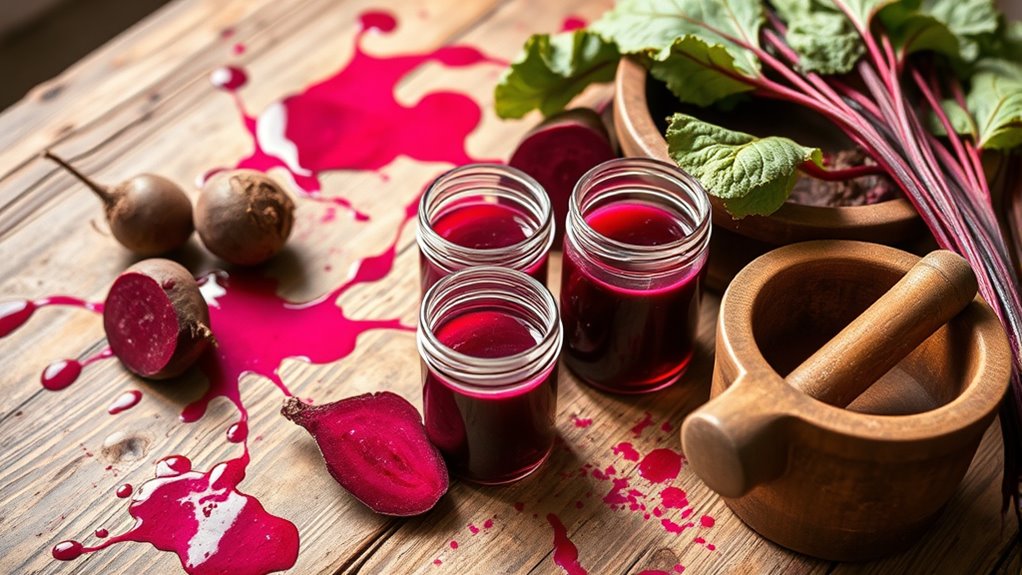
After you’ve prepared your beet juice for painting, it’s important to contemplate how to preserve and store your pigments to keep them fresh and vibrant for future use. Proper storage extends pigment longevity and ensures your colors stay vivid over time. Transfer your beet juice into airtight storage containers, such as glass jars or plastic bottles with secure lids, to prevent oxidation and contamination. Keep the containers in a cool, dark place to slow down color degradation. Label each container with the date and color to stay organized. Avoid exposure to direct sunlight or heat, which can fade the pigment. Additionally, understanding the importance of UV protection can help maintain the vibrancy of your pigments over time. By taking these steps, you’ll preserve the natural richness of your beet pigments and be ready for your next creative project whenever inspiration strikes. Using proper storage techniques ensures your pigments remain as lively as the day you made them, making your future projects even more successful.
Creative Ideas and Inspirations for Using Beet-Based Colors
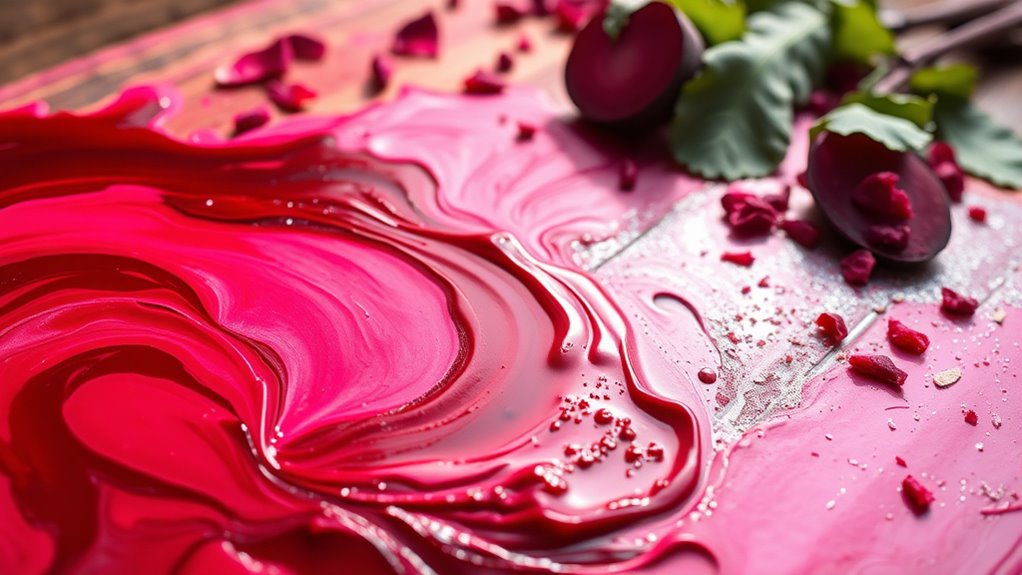
Beet-based colors offer a vibrant, natural alternative for a wide range of creative projects. You can experiment with beet dye history and cultural significance to inspire unique artwork. Use beet juice to create striking watercolor paintings or fabric dyes that reflect centuries-old traditions across different cultures. Incorporate these pigments into handmade cards, wall art, or even home decor for a personal touch rooted in nature. To deepen your understanding, explore this table:
| Beet Dye History | Cultural Significance |
|---|---|
| Originates from ancient Egypt | Used in Eastern European cuisine and rituals |
| Symbol of health and vigor | Represents fertility and prosperity in some cultures |
| Natural dyeing techniques from the Middle Ages | Celebrated in traditional festivals |
Let these ideas spark your creativity and connect you to a colorful history. Curiosity about natural pigments can also inspire innovative techniques and broaden your artistic horizons. Sustainable dyeing techniques are gaining popularity as eco-friendly alternatives in the art community.
Frequently Asked Questions
Are Beet-Based Pigments Suitable for Outdoor Murals?
You might wonder if beet-based pigments are suitable for outdoor murals. While they offer vibrant, natural color, their beet colorfastness and outdoor durability can vary. Generally, they’re less resistant to weather and UV exposure compared to synthetic paints. To improve longevity, consider sealing the mural properly and using weather-resistant topcoats. With proper treatment, beet pigments can be a sustainable, eye-catching choice for outdoor art projects.
How Long Do Beet Pigments Last on Different Surfaces?
Imagine your artwork as a vibrant garden that blooms brightly over time. Beet pigments offer charming color, but their pigment durability varies with surface type. On smooth surfaces like wood or metal, they tend to last longer, offering better surface longevity. However, on porous or outdoor surfaces exposed to weather, their vibrancy might fade faster. To guarantee lasting beauty, consider sealing and choosing the right surface for your mural.
Can Beet Juice Be Mixed With Other Natural Pigments?
You can definitely mix beet juice with other natural pigments for unique color mixing results. Just keep in mind that pigment stability varies; some combinations may fade faster or change over time. To guarantee your colors stay vibrant, test small amounts first and note how different pigments interact. Carefully mixing beet juice with other natural pigments can create beautiful, custom hues, but monitoring their stability helps preserve your artwork’s longevity.
Is There a Way to Make Beet Paint More Water-Resistant?
You can make beet juice paint more water-resistant by applying a beet juice sealant or a natural waterproofing agent. These products create a protective layer that prevents water from seeping in, making your beet-based paint more durable. Look for eco-friendly sealants specifically designed for natural pigments or try beeswax or plant-based resins, which can help turn your beet juice into a water-proof beet paint suitable for various surfaces.
Are Beet Pigments Safe for Children’S Art Projects?
You might wonder if beet pigments are safe for children’s art projects. The good news is, beet-derived pigments are generally considered child-safe pigments because they’re natural and non-toxic. They’re also edible art materials, making them ideal for young artists exploring creative expression without health worries. Just guarantee the pigments are pure and free from additives, so you can confidently let children experiment with these vibrant, safe, and eco-friendly colors.
Conclusion
By exploring beet juice as a natural pigment, you unveil a vibrant, eco-friendly palette that connects you to the earth. As you experiment and refine your techniques, you’ll discover that these vivid colors aren’t just beautiful—they’re sustainable and full of history. Embrace the process, trust your creativity, and watch your art come alive with the rich hues of beets. Who knew that such a humble vegetable could inspire such stunning masterpieces?
